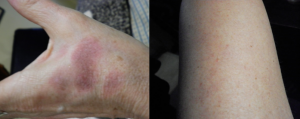My name is Janet Murray, I am 57 years old. I do not even know how to put my health story into words so that the human mind can understand the pain I have lived with. I lived in Canada and had been given many courses of Cipro for various illnesses over the last 30 years. Sometime ago, I began developing a lot of strange problems that no one could diagnose. I had GI difficulties, body pain, migraines every week, severe interstitial cystitis – so severe they wanted to remove my bladder. Thankfully, they did not. I was given many diagnoses too, including Chronic Fatigue Syndrome (CFS) and fibromyalgia. My cognitive abilities became so impaired. I loose words and my memory is shot. I had to leave my job with the Federal Government and work at home, at my own hours. I have been extremely fatigued for the last 25 years, but I never connected the dots between my health issues and the fluoroquinolone antibiotics like Cipro, Levaquin, Avelox and others until I blew out my forearm tendon, a classic post fluoroquinolone adverse reaction. It was only then that I began to learn more about the chronic symptoms that fluoroquinolone antibiotics evoke. I had them all and more. These symptoms didn’t appear all at once, and so it was difficult to identify at first, but over time, my illnesses became readily apparent and progressive to the point that it was no longer a question of if I was poisoned by a fluoroquinolone, but how badly.
Let me back up a little though and give you some more details. For years, I was fatigued and suffering from post fluoroquinolone reactions, but I didn’t know it. During that time, I had a long distance relationship with the love of my life in NJ. He waited and visited me back and forth for 10 years and I visited when I was well enough. When I was finally was well enough to immigrate to the US, I he asked me to marry him and so I stayed and had two wonderful years. We are jewelry designers and did the large shows. I functioned, at very low level and had to rest always, but I was living my dream. Even functioning at such a low level, I was happy after many years of hell.
One year, I kept getting bronchial issues and went to a walk in clinic. I was given Levaquin with Prednisone with NSAIDS and was on small dose of a benzodiazepine. Fluoroquinolones should never be used with steroids and NSAIDS, something I did not know at the time and apparently neither did the doctors. I took this combination again and again and again across that year.

My reaction to these drugs was delayed and so it did not occur to me to link the Levaquin or my past Cipro use to my strange symptoms. I have since learned that delayed adverse reactions are common post fluoroquinolones. After my first script that year I was more tired, could not walk far and something was not right. I didn’t know what though. During the second year I woke up with acid pain in the shoulder and could not lift it. I was told I had frozen shoulder. It was really a tendon rupture, common post fluoroquinolone.
The pain in my forearm and shoulder was horrific. It took 8 months before I could move my arm again. Then I woke up one morning and the same thing was happening on my buttock tendons. I had the same horrific, acid-like pain. Those tendons ruptured. I crawled for 4 months and tried to stand when I could. I could no longer walk, the pain was unbearable.
One morning I woke up and my entire body felt like it was beaten with a baseball bat. I had a shot-like feeling in the base of my neck. I sat up, vomited and shook. The next day my entire body started to shake. I felt like I had been electrocuted. I had sharp pains of electricity though my entire body. My skin felt ripped off of the bones with electric jabs and jolts. I had large jolts of electricity cursing through my body. I sat for 5 months frozen, feeling like I was living in a body of large, angry hornets, stinging me all over 24 hours a day, 7 days a week. The electrocutions were never ending.
My stomach almost shut down almost. Every joint in my body popped and cracked when I moved. My legs would not hold me. I lost the vision in my right eye due to a macular tear. I lost four teeth due severe periodontal damage. Other symptoms include:
- Up to 40 mouth sores at a time. The doctors say they look like burns or lesions. I wonder if it’s not a form of Steven-Johnson Syndrome.
- Swaying, if walking, dizzy, feeling of being “stoned” in the head.
- Sensory chills so severe with stinging that it takes 4 hot water bottles and wearing then down top as well.
- Arms and hands go dead and numb
- Constant feelings of being electrocuted
- Severe bowel constipation
- Intolerance to most foods
- Body hair stopped growing
- My skin has become very thin and transparent with enlarged veins.
- Pin prick sores on my legs and what looks like burns all over my body.

On the right, the burn-like lesions all over my body. On the left, the pin-prick sores on my legs. - I experience severe changes in body temperature.
- Feelings of terror and anxiety, not related to any surrounding, that come out of the blue
- Severe depression
- Hyperthyroid
And the strange symptoms go on and on. No one seemed to understand. I was almost dead. I dropped 40 pounds in three months. My heart pounds non-stop. Terrors and jolts surge through me. I was hysterical and crying.
The doctors keep saying I have fibromyalgia. FIBRO, I am being electrocuted..!! It couldn’t have fibro. I sat and thought this is NO normal illness but nothing showed up much on my tests. I have seen 50 doctors and no one can find anything. I feel like I have been poisoned. I soon learned, I was not alone. It was the Levaquin, a fluoroquinolone antibiotic that I have since learned, causes severe peripheral neurophathies, mitochondrial damage, and all of the seemingly unrelated symptoms that I have experienced over the last couple of years.
Right now, I am in so much pain, I cry daily. I wake up with night terrors, heart pounding. My feet feel frozen, as if they are dying due to extreme hypothermia – the kind mountain climbers face when their fingers and toes turn black. That’s what my feet feel like. My tongue burns like a hornet’s nest, day in, day out. It has been a year now, living with all over the body hornet stings and large tree like branch zapping about 40 at a time. I had the EMG and nerve biopsy that shows axonal swelling. I had an MRI showing two white matter lesions in the frontal lobe, the doctors say are consistent with MS or Lyme disease.
I should mention, I also tested positive for the MTHFR mutation that makes methylating vitamin B’s difficult. Even with the axonal damage, no one knows what to do. They tried to give me painkillers but I cannot tolerate them and vomit them back up. I have been on Paxil for years, more because I cannot seem to withdraw from it than anything else. Gabapentin, even at a high dose, does nothing and so I suffer. I cannot take this much longer. I cannot live with the nerve pain. Please help.
A few other clues that might be helpful for understanding this mess. When I tried acupuncture to relieve the nerve pain, it made it worse. The hornet’s nest sting lit up. Ditto for niacin. When I was given niacin, my body reacted very strongly. If there are doctors, researchers, patients, or anyone out there that can help reduce the pain I experience, who can help heal, reverse, or even just slow what seems to be a progression of increasing pain, please leave your comments here. Thank you.
Participate in Research
Hormones MatterTM is conducting research on the side effects and adverse events associated with the fluoroquinolone antibiotics, Cipro, Levaquin, Avelox and others: The Fluoroquinolone Antibiotics Side Effects Study. The study is anonymous, takes 20-30 minutes to complete and is open to anyone who has used a fluoroquinolone antibiotic. Please complete the study and help us understand the scope of fluoroquinolone reactions.
Hormones MatterTM conducts other crowdsourced surveys on medication reactions. To take one of our other surveys, click here.
To sign up for our newsletter and receive weekly updates on the latest research news, click here.
What Else Can I Do To Help?
Hormones MatterTM is completely unfunded at this juncture and we rely entirely on crowdsourcing and volunteers to conduct the research and produce quality health education materials for the public. If you’d like help us improve healthcare with better data, get involved. Become an advocate, spread the word about our site, our research and our mission. Suggest a study. Share a study. Join our team. Write for us. Partner with us. Help us grow. For more information contact us at: info@hormonesmatter.com.
To support Hormones Matter and our research projects – Crowdfund Us.

















